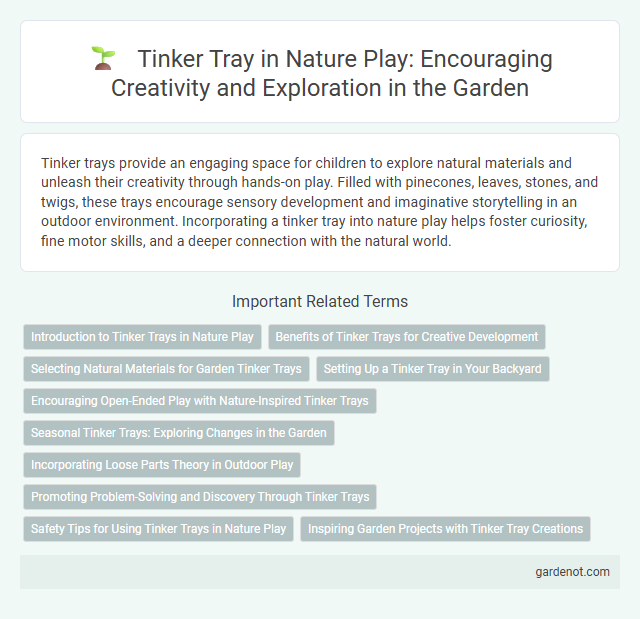Tinker trays provide an engaging space for children to explore natural materials and unleash their creativity through hands-on play. Filled with pinecones, leaves, stones, and twigs, these trays encourage sensory development and imaginative storytelling in an outdoor environment. Incorporating a tinker tray into nature play helps foster curiosity, fine motor skills, and a deeper connection with the natural world.
Introduction to Tinker Trays in Nature Play
Tinker trays in nature play offer a hands-on approach to creativity by incorporating natural materials like leaves, twigs, stones, and pinecones. These trays encourage sensory exploration and fine motor skill development through open-ended construction and imaginative play. Engaging with tinker trays fosters problem-solving abilities and enhances children's connection to the natural environment.
Benefits of Tinker Trays for Creative Development
Tinker trays foster hands-on exploration by encouraging children to manipulate various natural materials, which enhances fine motor skills and spatial awareness. These trays promote open-ended play, allowing kids to experiment with textures, shapes, and colors, boosting imaginative thinking and problem-solving abilities. Exposure to sensory-rich environments through tinker trays supports cognitive growth and emotional regulation during early creative development.
Selecting Natural Materials for Garden Tinker Trays
Choosing natural materials for garden tinker trays enhances sensory exploration and creativity in outdoor play. Include items like pinecones, smooth stones, dried leaves, seed pods, and twigs to inspire tactile engagement and imaginative construction. Prioritize collecting materials that are safe, non-toxic, and varied in texture and size to support diverse learning experiences.
Setting Up a Tinker Tray in Your Backyard
Setting up a tinker tray in your backyard involves selecting a sturdy tray or shallow box as the base, then filling it with natural materials such as sticks, leaves, pinecones, stones, and water. Incorporate tools like magnifying glasses, tweezers, and small containers to encourage exploration and fine motor skill development. Position the tinker tray in a shaded area to create a comfortable, inviting outdoor learning environment for children to engage with nature creatively.
Encouraging Open-Ended Play with Nature-Inspired Tinker Trays
Nature-inspired tinker trays foster open-ended play by providing children with a variety of natural materials such as leaves, twigs, pinecones, and stones, encouraging creativity and sensory exploration. These trays promote problem-solving skills and fine motor development through unstructured, imaginative activities that connect kids with the outdoors. Integrating elements from nature into play spaces supports cognitive growth and environmental awareness in young learners.
Seasonal Tinker Trays: Exploring Changes in the Garden
Seasonal Tinker Trays provide an interactive way for children to explore the natural cycles and transformations within a garden throughout the year. These trays typically feature a curated selection of leaves, seeds, pinecones, and flowers that reflect the current season, encouraging hands-on learning and sensory engagement. By manipulating natural materials found during each season, kids develop observation skills, creativity, and a deeper connection to the environment.
Incorporating Loose Parts Theory in Outdoor Play
Tinker trays enhance nature play by incorporating Loose Parts Theory, which emphasizes open-ended exploration using natural and found objects like sticks, leaves, stones, and pinecones. These loose parts stimulate creativity, problem-solving, and fine motor skills as children manipulate and combine materials to build, invent, and discover. Integrating loose parts into outdoor play environments fosters cognitive development and encourages sustainable, imaginative learning in natural settings.
Promoting Problem-Solving and Discovery Through Tinker Trays
Tinker trays encourage hands-on exploration by providing diverse natural materials that inspire creativity and critical thinking. Children engage in open-ended play, manipulating elements like rocks, sticks, and leaves to formulate hypotheses and test solutions. This process enhances cognitive development by fostering problem-solving skills and nurturing curiosity through self-directed discovery.
Safety Tips for Using Tinker Trays in Nature Play
Ensure Tinker trays are constructed from non-toxic, durable materials to prevent injury and exposure to harmful substances during nature play. Place trays on stable, level surfaces to avoid tipping and secure small parts to reduce choking hazards for children. Regularly inspect trays for wear or damage and clean thoroughly to maintain hygiene and promote a safe, engaging outdoor learning environment.
Inspiring Garden Projects with Tinker Tray Creations
Tinker Tray inspires imaginative garden projects by providing versatile tools and natural materials that encourage hands-on creativity and exploration. Gardeners and children use Tinker Tray creations to build miniature ecosystems, fairy gardens, and nature-inspired art installations that enhance outdoor learning and environmental awareness. These interactive projects foster a deeper connection to nature while promoting fine motor skills and innovative thinking.
Tinker tray Infographic

 gardenot.com
gardenot.com